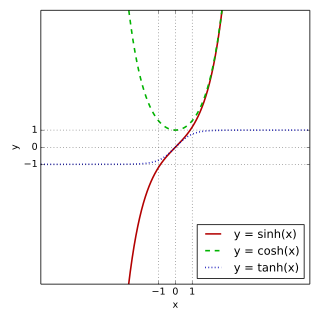Hyperbolic functions
mathematical function related with trigonometric functions From Wikipedia, the free encyclopedia
Remove ads
Hyperbolic functions are different versions of trigonometric functions. They are defined using a hyperbola instead of a circle. Also, as the derivatives of sin(t) and cos(t) are cos(t) and –sin(t), the derivatives of sinh(t) and cosh(t) are cosh(t) and sinh(t).

The basic hyperbolic functions are:[1]
- hyperbolic sine "sinh" (/ˈsɪŋ, ˈsɪntʃ, ˈʃaɪn/),[2]
- hyperbolic cosine "cosh" (/ˈkɒʃ, ˈkoʊʃ/),
Using these, you can get:[3]
- hyperbolic tangent "tanh" (/ˈtæŋ, ˈtæntʃ, ˈθæn/),
- hyperbolic cotangent "coth" (/ˈkɒθ, ˈkoʊθ/),
- hyperbolic secant "sech" (/ˈsɛtʃ, ˈʃɛk/),
- hyperbolic cosecant "csch" or "cosech" (/ˈkoʊsɛtʃ, ˈkoʊʃɛk/)
and these have similar logic to the normal trigonometric functions.
The inverse hyperbolic functions are:
- inverse hyperbolic sine "arsinh" (also "sinh−1", "asinh" or sometimes "arcsinh")[4][5]
- inverse hyperbolic cosine "arcosh" (also "cosh−1", "acosh" or sometimes "arccosh")
- inverse hyperbolic tangent "artanh" (also "tanh−1", "atanh" or sometimes "arctanh")
- inverse hyperbolic cotangent "arcoth" (also "coth−1", "acoth" or sometimes "arccoth")
- inverse hyperbolic secant "arsech" (also "sech−1", "asech" or sometimes "arcsech")
- inverse hyperbolic cosecant "arcsch" (also "arcosech", "csch−1", "cosech−1","acsch", "acosech", or sometimes "arccsch" or "arccosech")
Remove ads
Definitions

With hyperbolic angle u, the hyperbolic functions sinh and cosh can be defined using the exponential function eu.[1][3] In the figure .
Exponential definitions


- Hyperbolic sine: the odd part of the exponential function, that is,
- Hyperbolic cosine: the even part of the exponential function, that is,


- Hyperbolic tangent:
- Hyperbolic cotangent: for x ≠ 0,
- Hyperbolic secant:
- Hyperbolic cosecant: for x ≠ 0,
Remove ads
Related pages
References
Wikiwand - on
Seamless Wikipedia browsing. On steroids.
Remove ads







